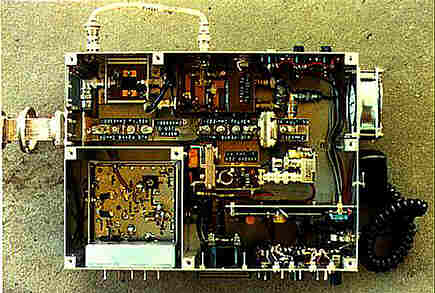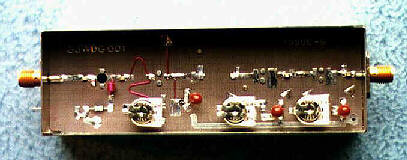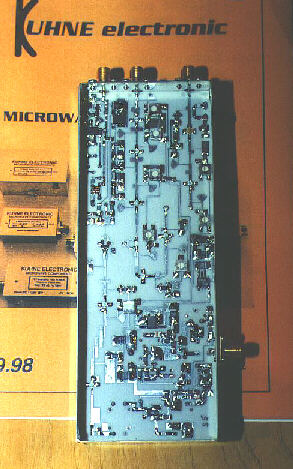A BRIEF HISTORY OF 10GHz AMATEUR MICROWAVESThe UK story........ |
| In
the beginning....
10GHz is probably, in the UK at least, the most popular of the amateur microwave bands. It has seen some sixty years of development since the first experimental contacts made by W2RJM and W2JN in the USA during 1946. These two "pioneers" could not have known what was to follow their 2 mile (3km+) contact! A year later, in 1947 the world 3cm record was extended to 7.65 miles after a contact between W6IFE/3 and W4HPJ/3. W6IFE is now the callsign of the San Bernardino Microwave Society, the oldest amateur microwave group in the world and one with a fascinating history of its own. Even before that epic QSO, the Radio Society of Great Britain had published a series of articles in its journal, "The RGSB Bulletin" (or the "Bull" as it was known to UK amateurs) during 1943, a period when amateurs were not allowed to transmit signals as we had a thing going on with a man called Adolf at the time! These articles, entitled "Communication on centimetre waves" were followed up in 1947 with a booklet about microwaves, "Microwave Technique". Its 54 pages cost readers 11 pence in present day UK terms. By that time there were a few UK amateurs taking an interest in microwaves. Two of them, Des Clift, G3BAK and G3LZ, began experimenting in 1949 and, in January 1950, were rewarded with the first UK two-way contact on the 10GHz band. Des (pictured below) eventually migrated to Australia where he carried on his microwave activities, mainly on the 5.6GHz band, until his death in early 2005. He was VK2AHC in New South Wales at first but then relocated to South Australia as VK5ZO.
His 10GHz equipment for that 1950 contact with G3LZ consisted of a mains powered klystron transmitter/receiver and the path was just a "few miles" (actually about 1.75 miles) across the Manchester Ship Canal in North West England.Of just as much interest was his use of 70cm for talkback. At that time even the 432MHz band was for radio pioneers!
Another 3cm pioneer was Jim Spragg, G3APY. Sadly Jim became a Silent Key in 1997 but his contribution to amateur microwave radio will be remembered for a long time to come. On September 23rd, 1950, he made contact with G8UZ over a new world record distance of 12 miles. (Details of this contact can be found in the RSGB Bulletin for October 1950, page 138) The R.S.G.B Bulletin for January, 1951, records Jim's next world 10GHz record contact, this time with G3ENS/P over a distance of 27 miles. This took place on 22 October 1950, just a month after his contact with G8UZ. Jim's gear was a dual band affair, 23cm plus 3cm and was mounted on the top of his saloon car. Separate, 5 element yagi antennas were employed on the 23cm transmitter/receiver system while an 18 inch diameter dish with dipole/reflector feed (waveguide fed) radiated the 3cm RF. On 23cm, CV90 oscillators were used with a klystron on 3cm for wideband FM . A common IF/AF unit was employed on both bands. Simple crystal diode receive mixers were employed on both 23 and 3cm. Most interestly for this writer, Jim used the Alport Height location at IO93FB, near the town of Matlock in Derbyshire for much of his UHF and microwave work. A photograph of that location as it is today, 1035 feet above sea level, with G3PHO/P in evidence, can be seen in the Photo Album pages. By the way, another page in the same issue of the RSGB Bulletin mentioned above details the 70cm activity tests held in 1950. Reading the reports is very much like reading those for the 10GHz activity days of the 1970s and '80s, such was the state of the art on UHF in those days. G3APY was in the forefront of this as well as experimenting on 10GHz. The UK record on 70cm was only 161 miles at that time...dead easy now of course, but a milestone in 1950! Klystrons...10GHz wideband FMIn the UK, the 10GHz band was exploited by a small group of dedicated enthusiasts who built simple klystron transceivers, using wideband FM modulation. The most popular klystron during the 1960's and 70's was the 723A/B. ( This was identical in appearance to the 3GHz klystron type 726A, shown below). These were really designed to work best at around 9.5GHz but amateurs found ways of "bending" them up to the lower 100MHz of the 10GHz band (the UK had 10.0 to 10.5GHz available at that time).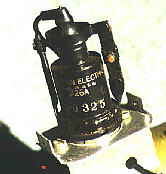 Power
outputs were in the region of a few milliwatts. The klystron was used
as an oscillator on both transmit and receive, the wideband FM modulation
being applied to its repeller. Unfortunately, fairly high voltages
(by modern standards) were needed, up to 300 volts or so, and
portable power supplies were usually of the 12v dc input/300v dc output
inverter variety. As a result, they often produced a distinctive whine
on the modulation! Many amateurs used directional couplers in their
equipment so that the klystron oscillator could be used as a receiver
local oscillator as well as a transmitter. Waveguide switches and
other items of waveguide 16 "plumbing" made these rigs bulky
and off-putting to non-microwavers! Frequently, a duplex arrangement
was used with a common IF of 30MHz or 100MHz (with bandwidths around
200kHz). One station in a contact would transmit, say, a signal on
10.100GHz and the station at the other end would set his local oscillator
on 10.070GHz (10.130GHz)to hear the signal in a 30MHz receiver. The
first station, also equipped with a 30MHz receive IF would hear the
second station at the same time. For initial signal finding, each
station would modulate the transmitter with a 1kHz tone. When the
two stations found each other the two tones would beat with each other
in an unmistakable manner! The 10GHz receive front end was, in most
cases, a simple diode (for example a 1N23E or similar). Power
outputs were in the region of a few milliwatts. The klystron was used
as an oscillator on both transmit and receive, the wideband FM modulation
being applied to its repeller. Unfortunately, fairly high voltages
(by modern standards) were needed, up to 300 volts or so, and
portable power supplies were usually of the 12v dc input/300v dc output
inverter variety. As a result, they often produced a distinctive whine
on the modulation! Many amateurs used directional couplers in their
equipment so that the klystron oscillator could be used as a receiver
local oscillator as well as a transmitter. Waveguide switches and
other items of waveguide 16 "plumbing" made these rigs bulky
and off-putting to non-microwavers! Frequently, a duplex arrangement
was used with a common IF of 30MHz or 100MHz (with bandwidths around
200kHz). One station in a contact would transmit, say, a signal on
10.100GHz and the station at the other end would set his local oscillator
on 10.070GHz (10.130GHz)to hear the signal in a 30MHz receiver. The
first station, also equipped with a 30MHz receive IF would hear the
second station at the same time. For initial signal finding, each
station would modulate the transmitter with a 1kHz tone. When the
two stations found each other the two tones would beat with each other
in an unmistakable manner! The 10GHz receive front end was, in most
cases, a simple diode (for example a 1N23E or similar).
In 1959, Bob G3GNR and Don G3JHM, had their very first 10GHz QSO,over a 4km path(later extended to 30km) between Worthing and Newhaven, in Sussex They were using the "evergreen" modified 723A/B on 10050 MHz at about 10mW o/p and their PSUs were two small rotary converters running from 12V batteries. The receivers were single-ended mixers with LOs fed by a 10dB directional coupler and NF measured at 11dB! Both these operators were still very active on 10GHz up to the late 1990s and are probably two of the longest serving 10GHz ops, at least in the UK. It was equipment of this type that enabled the 150km "barrier" to be broken for the first time in the UK, when G3RPE and G3ZGO made contact between Dartmoor (SW England) and the Prescelly Mountains (SW Wales). This distance became the yardstick by which the rest of us measured our 10GHz performance. The RSGB Microwave Distance Awards still recognise that level of achievement .... easy now with modern narrowband gear but quite difficult for simple wideband equipment of those days. Dain Evans, G3RPE, who wrote the first microwave column in the RSGB's RadCom magazine, became chairman of the RSGB Microwave Committee and then RSGB Microwave Spectrum Manager. Until his untimely death, he worked unstintingly for the good of UK microwavers. He is remembered to us all in the UK by the G3RPE Trophy, awarded to the leading station in the annual 10GHz Cumulative Contests, formerly run by RSGB and now by the UK MIcrowave Group The Americans put on the pressure..
Gunn Diodes and new records...During the mid 1970's the Gunn diode appeared on the amateur market and revolutionised the wideband scene. Power supplies shrank, the Gunns requiring a low current supply of around 7 volts or so. Since the diodes were also very small (a few millimetres long), 10GHz equipment became highly portable and the UK saw what many Old Timers still regard as the "Golden Age" of 3cm! Almost all active 10GHz amateurs in the UK would operate from portable locations. The summer cumulative contests, organised by the RSGB Microwave Committee became very popular and the hilltops of North Wales, the Pennines, the North and South Downs, as well as many other areas, "grew" tripods, dishes and 2 metre talkback stations on a regular basis.Here at G3PHO I
developed a compact 3cm transceiver based on a Gunn diode oscillator,
a 1N23E RX mixer diode and a small solid state 30MHz IF (with a
1.5dB NF post-mixer amplifier). Duplex operation was still very much the norm, as in klystron days, but 10.7MHz IFs replaced the 30MHz ones in many cases. The limitations of the
line-of-sight path became a challenge to 10GHz operators... Propagation studies open up the potential for real 10GHz DX...Some excellent DX was worked with simple Gunn equipment of this type. Operators such as GM3OXX/P, GW3PPF/P, GW4BRS/P, G3RPE, GM8BKE (now G8BKE) and many others made long distance contacts, during the 1970s, that would still give pleasure to some narrowband operators today. The longest line-of-sight path worked at that time was that between the summit of Mt. Snowdon (North Wales) and the Cairnsmore of Carsphairn (South West Scotland). At 245km it represented the best you could do in the UK without enhanced propagation. (Your scribe repeated the path in 1987) . Longer paths than this were worked, however, due to the inquisitiveness of amateurs such as GW3PPF, who saw the potential of the moist air ducts that often form over the sea. He, and others, spent a considerable amount of time and money travelling around the UK to establish the existence of these "super refraction" paths, often hundreds of kilometres in length. In fact, the longest path covered by this propagation mode during the 1970's was a new world DX record (on the 14th August 1976) between Pendeen Sands, Cornwall and Portpatrick in South West Scotland, a distance 521km, thus exceeding the W7's record of the 1960 period by a handsome margin of almost 100km. For this remarkable contact G4BRS/P (The Barry Radio Society) and GM3OXX/P used simple 10 milliwatt Gunn transceivers to small dishes (60 to 75cm diameter). The signals were exchanged directly on 10GHz, without recourse to prior talkback on 144MHz. The signals peaked 45dB above noise.......very loud ones! A super-refractive sea duct was the means by which the two stations were able to work well beyond line-of-sight with such low power and wide bandwidth receivers. They had made eight previous, separate attempts for this world record by the way!World 10GHz records made since, either on wideband (by Italians) or narrowband (by Australians) have made use of this "super-refraction" propagation mode to exceed even 1000km! (Present world record is now over 2000k!) Halcyon Days!The 1970's produced many "firsts" for UK 10GHz operators.The first GW to GM contact took place in 1972 when GW3CKT/P worked GM8AZU/P (now G4NNS). The QSO was a world record at the time, only to be exceeded a few months later by GM3OXX/P. A photograph of the GM team of operators, carrying the gear (including an 80cm dish) up the Cairnsmore of Fleet, appeared on the front cover of Short Wave Magazine a few months later and is worth seeing if only for a look at G8DKK's multi-coloured trousers! The first G to PA contact was made on the 3rd August 1975 by G8APP/P and PA0KKZ. The former used a 20mW klystron while the latter ran just 3 milliwatts to cover the 240km path. Both stations were again located at or very near sea-level. This contact had immediately followed a one way attempt by G4ALN, who used 10 mW to a DUST BIN LID as an antenna!! G8APP/P was located at Walton-on-the Naze, a site that has become famous in the annals of 10GHz in the UK and one that is still used by the UHF/Microwave contest group G0VHF. It is arguably the finest /P location in the UK for working into the European Continent. By the November of 1976 some 12 countries had been worked by G stations. The first GI to GM contact was made in August 1976. Germany, Denmark, Norway and Sweden were still awaiting contact. Narrowband developments...Throughout the wideband period described above, there existed a small group of British amateurs who were developing crystal-controlled, narrowband systems for 10GHz. Such systems usually consisted of a vhf crystal oscillator, with watts of output in some cases, driving a chain of varactor diode multipliers. The multiplier chains provided both narrowband transmitter RF (cw and nbFM) as well as local oscillator drive for simple diode mixer receivers. At this time there were no transistor devices available that would work as amplifiers or mixers at 10GHz.Perhaps the most well-known team of operators at that time was the G3BNL - G3EEZ partnership. Les and Alan both built remarkable (for that period) narrowband systems that were used to establish UK records on all microwave bands at the time. Unfortunately G3BNL is now a Silent Key and he is greatly missed by the UK microwave fraternity. His name lives on in the form of the G3BNL Trophy, awarded annually to a microwave amateur for expertise and innovation in home construction. Another narrowband pioneer in the UK was Mike Walters, G3JVL. During the period when Gunn diode wideband equipment was very popular, Mike was experimenting with image recovery, narrowband filter systems leading to the development of what has become known as the "JVL RIG". This consisted of a step-recovery diode multiplier (mounted in waveguide 16) driven by a lower frequency crystal oscillator source.....typically 384MHz at around 500mW. The multiplier produced a low power ( c. 5 to 10mW) at 10224MHz which passed through a narrow bandwidth, waveguide filter. This filter was the secret of the JVL rig's success, for its three cavities were iris coupled and reduced the image signal to negligible proportions. The filtered 10224MHz then drove a waveguide in-line diode mixer to which a few milliwatts of 144MHz was applied and the desired 10368MHz ssb/cw signal was then passed through another three-stage, iris-coupled filter to produce around 1 mW at the antenna port. The JVL RIG was therefore a complete transceiver. As a receiver, it could certainly hold its own ,since, as a result of the excellent image rejection, noise figures of 6 to 7dB were possible with the "bare" diode mixer ............... and this without a GaAsFET preamp in sight! The following photograph
shows a complete JVL rig, built by Lyle, VK2ALU. The 384MHz local oscillator is lower left and drives a small amplifier at 384MHz into a multiplier to 1152MHz (top of photograph). In this example 1152MHz drives the JVL waveguide multiplier to 10GHz, The long waveguide section of the JVL system is clearly visible in the centre of the picture. Other circuitry show includes receive post mixer amplifier (at 144MHz and send/receive changeover system). This little rig enabled many a UK amateur to taste 10GHz narrowband for the first time, but unless you had a TWT amplifier, the 500 microwatt to one milliwatt of RF output did not get out much better than the wideband rigs of the day, although the writer did work several obstructed paths with his JVL, paths that the Gunn equipment would not work. Something was obviously needed to raise the output into the dozens of milliwatts region.....the GaAsFET!.................. GaAsFETs, G4DDK and G3WDG.....During the mid to late 1980's, a number of German designs for solid-state, GaAsFET-based systems appeared in the UK. A commercial transceiver made by SSB Products retailed at over £400 sterling and many amateurs thought the dreaded "black box" had finally arrived on microwaves! However the microwave bands do not attract amateurs with little or no interest in home construction. The reverse is true, for the microwave regions are a "magnet" for amateurs who have grown tired of the commercial equipment approach to our hobby. A few SSB Product systems were sold but the home constructor was spared the headache of making up his or her mind whether or not to purchase one. Sam Jewell, G4DDK was, at this time, developing a series of compact local oscillator printed circuit designs for the 1 GHz region. In March 1987, the RSGB Microwave Newsletter published the DDK001 design....."A local Oscillator Source for 1152MHz". This was closely followed by a companion1 watt amplifier, the DDK002. These two pcbs, once built up into working modules, offered a reliable narrowband route through to the 23cm band and provided the basis of transverters for the higher microwave frequencies.It wasn't long before Sam, G4DDK, introduced the DDK004 board giving 10 to 12 milliwatts out at around 2.5GHz. This little gem was to have a profound effect on the way 10GHz narrowband was to go in the UK for, at the same time as Sam was doing his development work, Charlie Suckling, G3WDG, was working on a 10GHz transverter system that was to bring ssb/cw to all UK 10GHz operators. In fact he virtually "killed off" wideband FM as the preferred mode of operation! Charlie's designs use the G4DDK driver modules to feed a transmit multiplier/amplifier module and a receiver, each using cheap and readily available GaAsFET devices . They included RF amplifiers to provide what was, in 1990, HIGH power (50 to 100 milliwatts) and low noise receivers (around 2 to 3dB NF). The WDG 10GHz kits soon became the most popular and widespread 3cm equipment in the UK. As if by fate, a large quantity of cheap (approx. £2 sterling each!) 10GHz GaAsFETs became available on the surplus market, just as Charlie was developing his system. The supplier, J.Birkett of Lincoln, and the devices' code names "Red Spot" and "Black Spot" became by-words in the UK microwaver's vocabulary! These photos illustrate some of the G4DDK and G3WDG microwave modules: The G4DDK 004 source for 2.4 -2.6GHz
BELOW: A partially completed G3WDG001 unit (10GHz x4 multiplier/amplifier)
This unit is built on teflon pcb and mounted in a tinplate box 11cm x 3.5cm x 3cm. A basic WDG transverter for 10GHz uses a WDG001 x4 multiplier/amp, a WDG002 receive converter and a WDG003 transmit downconverter. The DKK004 source at 2.5GHz drives both local oscillators. All that is needed for full transceiver operation is a low power 144MHz transceiver such as the IC202 or FT290, microwave coaxial relay and a +12 volt DC power supply. The modules are constructed in small tinplate boxes and are fully connectorised in SMA. The use of tinplate boxes allows very efficient shielding and pcb mounting. Charlie later added several other modules to the WDG system, including a 1 watt PA and a sub 2dB HEMT receive preamp. These kits and many others (including designs for the 23cm and 13cm bands) are available from the Microwave Components Service, operated by Petra Suckling, G4KGC, the wife of G3WDG. Charlie proved how good his equipment was by making the very first UK to Australia EME (Earth-Moon-Earth)contact when in 1995 he worked VK2ALU, Lyle Patison of Wollongong, New Sout Wales, Australia. This historic contact saw WDG equipment in use at both ends of the contact. In the early 1990's ... A number of surplus M/A-COMM 10.5GHz data link transceivers arrived on the UK surplus market. Nicknamed the "White Box", it sold for around £100 sterling, quite cheap for a 200mW transceiver! Dozens have been modified by UK amateurs and they often form the heart of a home or portable station and microwave beacons. Modification details were already available from the USA, where the "White Boxes" appeared in their hundreds, particular on the West Coast. Modifications were also developed in the UK. G3WDG's WDG 005 receive preamp fits nicely into the Box for example, and improved the "barefoot" ring mixer's 11dB NF to around 2 to 3dB. The WDG HEMT preamp can be added to get down towards 1dB NF. The "White Box" was the basis of the writer's 10GHz system in those days and is still occasionally used for both home and portable operation. The late 1990's to early 21st century ...The G3WDG/G4DDK systems
led to more and more HOME STATION operating in the UK. A
number of cheap (sometimes free!) 4 to 5 watt Travelling Wave Tube
amplifiers (TWTs) became available during the '90s. These were easily
driven by a couple of milliwatts. Higher powers were also around
with quite a few UK amateurs running power outputs in excess of
10 watts and one or two around 60 watts. In the latter half of the 1990s, a series of excellent amateur microwave kitsets, including complete transverters, oscillator/multipliers and power amplifiers, came ontothe European market. These are produced in Germany by three main companies: Eisch Electronics, Kuhne Electronic (DB6NT) and Philip Prinz (DL2AM). They are all stillgoing strong in 2005. There's no doubt, however, that Michael, DB6NT and Kuhne Electronics has changed the face of amateur microwaves, certainly in Europe, if not the world, as he now supplies both kits and ready made equipment available from 1.2GHz right up into the submillimetre bands and all at an affordable price and of excellent quality. Nowadays there must be few active microwavers in Europe who have not at least one item from the DB6NT "stable" in their shack! Indeed, The writer's own equipment is based largely around DB6NT transverter kits. In the USA, the Down East Microwave company has grown into that continent's major supplier of amateur microwave equipment with many original US designs. Where to next?Today, in 2020, in addition to the excellent German, UK and USA kitsets, there is a wide variety of SOLID STATE power amplifier (SSPAs) easily obtainable and indeed produced for the amateur microwave market. Power levels of over 50 watts are available (at a price!) on 10GHz while bands lower than 10GHz have seen the widespread availability of surplus SSPAs from commercial radio links and abandoned defence contracts.These power levels and home station operating have seen the exploitation of unusual propagation modes such as rainscatter and aircraft reflection, as well as troposcatter and ducting, being used to work some very long paths in the UK and over the sea to Europe. "Entry level" 10GHz narrowband power levels of 1 watt are now "de riguer". In the UK at least, the 60 to 90cm, offset fed dish antenna(often ex- satellite TV)is now the most popular 10GHz antenna and contacts up to 400km are the norm. Some home stations work daily skeds over this sort of distance and have 800 to m1000km+ contacts when tropo conditions are good. During the monthly contest weekends, when activity is at its highest,portable stations often work long distances on 10GHz narrowband, sometimes beyond 600km under apparently flat band conditions! This is usually due to the exploitation of aircraft and rainscatter. In spite of the growth of home stations, portable operation is still popular, as any Cumulative Contest weekend will show. E.M.E (Earth-Moon-Earth) propagation is now quite common on 10GHz and there are now a number of UK operators equipped to make overseas contacts via the Moon. The contacts have been a little "easier"(!)by the introduction of computer software that not only keeps the large dish on target but also sends the contact exchange details by datamode, often at a level at the limit of, or even below, the human ear. Today, the 24GHz band is now going through a similar sort of "revolution" that 10GHz had a decade ago. Narrowband and "high" power (3 watts)has arrived at 24GHz......kits and surplus "boxes" are changing that band too! But that's another story .... 10GHz may have become "old hat" for some people but there is still plenty to do there and room for more converts to microwaves......
SO WHY DON'T YOU TRY 1OGHz?ACKNOWLEDGEMENTS: The writer wishes to thank the following for their help and information in getting this article together: Jonathan Naylor, G4KLX, Bill Capstick, G3JYP, Des Clift, VK5ZO, Lyle Patison, VK2ALU, Bryan Harber, G8DKK, Jimmy Oldaker, W7CQ (Updated 1 January 2006)
|

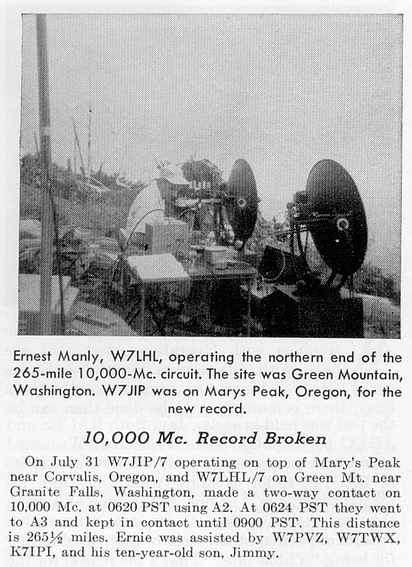
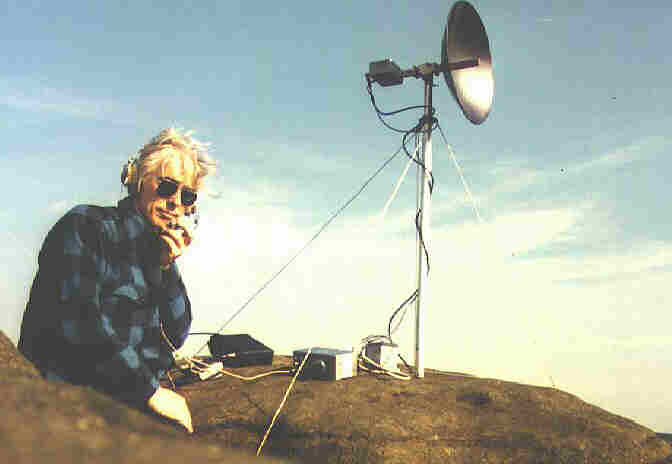 This,
together with an 18 inch dish and short portable mast, an IC202S
2 metre ssb handheld with a quarter wave whip antenna and a small
12 volt "dryfit" battery, was frequently backpacked up some of
the country's highest mountains in the search of longer and longer
line of sight paths. Some of the photographs in the
This,
together with an 18 inch dish and short portable mast, an IC202S
2 metre ssb handheld with a quarter wave whip antenna and a small
12 volt "dryfit" battery, was frequently backpacked up some of
the country's highest mountains in the search of longer and longer
line of sight paths. Some of the photographs in the